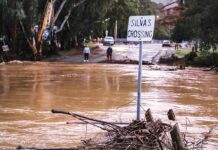GILROY
– If more than 70 of Northern California’s earthquake experts
are right, there’s a 70 percent chance a major quake will rock the
Bay Area by 2030.
GILROY – If more than 70 of Northern California’s earthquake experts are right, there’s a 70 percent chance a major quake will rock the Bay Area by 2030.
In South County, however, it could be 50 to 70 years before a 6.7 or above magnitude tremor radiates from one of the two large fault lines bordering Gilroy to the east and west.
“In the mountains to the west of Gilroy, you have the San Andreas Fault; to the east, you have the Calaveras Fault,” said David Oppenheimer, a seismologist and manager of the Northern California Earthquake Hazards Team. “The good news for (South County) is that the southern segment of the San Andreas is not active, and studies show that the Calaveras won’t have a major slide for another 50 to 70 years.”
Oppenheimer’s comments are based on his team’s recent studies of the South County faults and the 1999 report issued by the U.S. Geological Survey detailing the 70 percent likelihood of another large-scale earthquake hitting the Bay Area during the next 27 years. Damage from that quake is expected to be on par with the devastating 1989 Loma Prieta Quake, which measured between 6.9 and 7.1 in magnitude.
The same report says there is an 80 percent chance of a smaller quake in the area during that time – 6 to 6.7 – which could cause serious damage in populated areas. An earthquake larger than 6.7 in magnitude would cause damage throughout the Bay Area and result in severe destruction within a 25-mile radius of the epicenter, according to the USGS.
On Oct. 17, 1989, the Loma Prieta quake killed 67 people, injured 3,757 and caused $6 billion in damage throughout the Bay Area.
“The difference of the predicted quake and Loma Prieta will be the epicenter,” said Oppenheimer, noting that Loma Prieta’s epicenter was on the San Andreas Fault in the Santa Cruz Mountains less than 15 miles from Morgan Hill. “This time it will likely be in the East Bay, although the shaking in (South County) will still be significant.”
Recent studies by the USGS have taken the 1999 report even further, braking down the likelihood in which the next major earthquake will be produced by each of the Bay Area’s seven major faults.
The report lists the San Andreas Fault with a 21 percent chance of creating a major shakedown by 2030, trailing only the Rogers Creek Fault near Hayward, which has a 32 percent chance of being the next major quake’s epicenter. But if the San Andreas – which runs through Gilroy north past Marin County – does make a large movement, it likely will be centered somewhere in the Peninsula, Oppenheimer said.
“With a 6.7 (magnitude) or greater (quake), there will be major structural damage within a 25-mile radius of the epicenter,” Oppenheimer said. “With our recent findings, it looks like South County will be in relatively good shape if the rupture is in the Peninsula or East Bay.”
The Calaveras Fault is not far behind the San Andreas at 18 percent, but Oppenheimer said it shouldn’t be considered too dangerous.
“Data suggests that it is a creeping fault,” he said. “That means it slides a few millimeters in a year and won’t likely cause a quake of 3 or above. It takes a plate to move 1 meter instantly for a 6 or greater.”
Regardless of the studies, reports and statistics comprised by the USGS, anywhere in coastal California is earthquake country, and residents should be prepared for anything, said Peter Anderson of Pacific Geotechnical Engineering in Morgan Hill.
Anderson’s company works with local developers, businesses and home owners to determine if South County land is safe to build on. Surveys like Anderson’s are required by state law to ensure new development meets earthquake codes.
“After the Loma Prieta we learned that if buildings were constructed to current codes they did just fine,” said Anderson, using Gilroy’s severely damaged Old City Hall – which was built in 1905 on Monterey and Sixth streets – as an example. “But if you’re built on unstable ground – even if you’re up to code – you’re screwed.”
Anderson said that although most South County residents take the threat of an earthquake seriously, there are still many buildings that would be destroyed if there was a major earthquake tomorrow.
“If we went for a drive around South County right now, I could point out a number of beautiful homes built on really unstable ground,” he said. “Many people felt that Loma Prieta was the big one, and they got relaxed. It wasn’t the big one, and these structures are in trouble if the San Andreas moves again.”
An earthquake on the San Andreas is created from the motion of the overlapping Pacific and North American geological plates, which meet at the fault. The plates are thick slabs that connected continents ride on top of, like logs stuck in ice. The length of the fault multiplied by the depth usually equals the magnitude of the quake, according to the USGS.
USGS studies on Bay Area faults have benefited greatly from improved technology during the past five years, including improved computer simulations, more precise tracking of plate movements and measurements by space satellites, and the digging of trenches along faults to measure for depth.
But even with the improved technology, all earthquake predictions should be taken with a grain of salt, Oppenheimer said.
“The truth is that you can never be 100-percent sure,” said Oppenheimer, who has dedicated 25 years of his life to studying earthquakes. “There’s always the chance of that wild card that we can’t predict.”
For more information on the anticipated effects of a Bay Area earthquake on South County and earthquake preparedness go to abag.ca.gov.
Quake safety tips:
• Have enough food and water for three days.
• Have a first-aid kit stocked and ready and also have essential medications on hand for those who need them.
• Keep a flashlight, battery-operated radio and extra batteries handy so that you can see if the power goes out, and you can receive updates on what to do.
• Fasten all large appliances, bookcases, pictures and other heavy objects to the wall so they are less likely to fall over.
• Make sure there is a working fire extinguisher in the home and that everyone knows how to use it.
• Keep written instructions on how to turn off gas, electricity and water.
Earthquake: Duck, Cover and Hold
No matter where you are, know how to protect yourself and your family during an earthquake. Practice taking cover as if there were an earthquake and learn the safest places in your home and work. Practice getting out of your home – see if the planned exits are clear and if they can become blocked in an earthquake. Practice turning off your electricity and water. Know how to turn off the gas, but do not practice this step. In the event of an earthquake, once you turn off your gas, only your utility company should turn it back on for safety reasons.
Duck
DUCK or DROP down on the floor.
Cover
Take COVER under a sturdy desk, table or other furniture. If that is not possible, seek cover against an interior wall and protect your head and neck with your arms. Avoid danger spots near windows, hanging objects, mirrors or tall furniture.
Hold
If you take cover under a sturdy piece of furniture, hold on to it, and be prepared to move with it. Hold the position until the ground stops shaking and it is safe to move.












